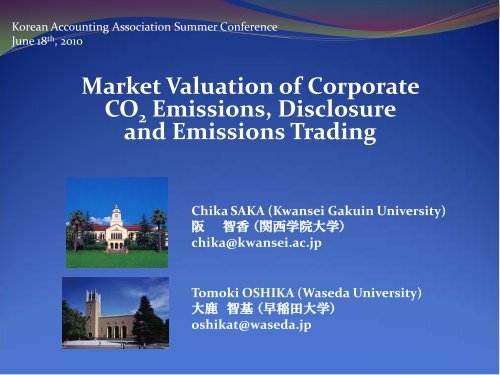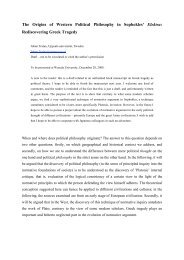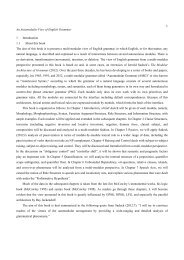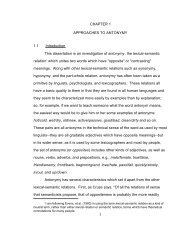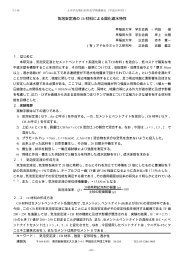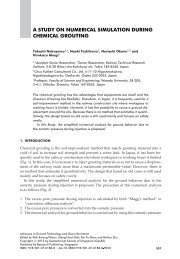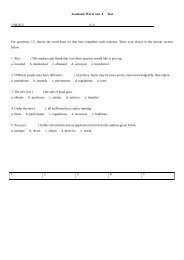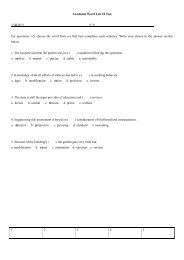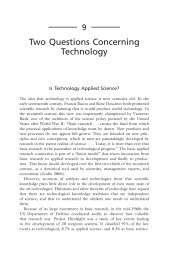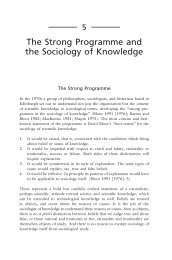1. Introduction - 早稲田大学
1. Introduction - 早稲田大学
1. Introduction - 早稲田大学
You also want an ePaper? Increase the reach of your titles
YUMPU automatically turns print PDFs into web optimized ePapers that Google loves.
Korean Accounting Association Summer Conference<br />
June 18 th , 2010<br />
Market Valuation of Corporate<br />
CO 2 Emissions, Disclosure<br />
and Emissions Trading<br />
Chika SAKA (Kwansei Gakuin University)<br />
阪 智香 (関西学院大学)<br />
chika@kwansei.ac.jp<br />
Tomoki OSHIKA (Waseda University)<br />
大鹿 智基 (<strong>早稲田大学</strong>)<br />
oshikat@waseda.jp
Saka and Oshika (2010) at KAA<br />
<strong>1.</strong> <strong>Introduction</strong><br />
CO2 emissions and global warming
Saka and Oshika (2010) at KAA<br />
Kyoto Protocol<br />
<strong>1.</strong> <strong>Introduction</strong>
Saka and Oshika (2010) at KAA<br />
<strong>1.</strong> <strong>Introduction</strong><br />
CO2 emission in Japan<br />
We have to reduce 9%.<br />
Government plans<br />
Emissions trading<br />
Environmental laws<br />
Environmental taxes<br />
Risk & expenditure<br />
vs. opportunity & benefit
Saka and Oshika (2010) at KAA<br />
<strong>1.</strong> <strong>Introduction</strong><br />
Post-Kyoto (COP15)<br />
“CO2” is one of the world<br />
high-priority issues<br />
This research analyzes on market<br />
valuation of<br />
Corporate CO 2 emissions<br />
Corporate CO 2-related disclosure<br />
Participation in emissions trading<br />
schemes (ETS)<br />
KYOTO Protocol Our Future
Saka and Oshika (2010) at KAA<br />
2. Previous Research and Hypotheses<br />
Previous Researches<br />
Cormier and Magnan (1997) , Cormier and Magnan (1997) ,<br />
Konar and Cohen (2001)<br />
Barth and McNichols (1994) , Garber and Hammitt (1998),<br />
Bae and Sami (2005), Graham et al. (2001)<br />
Impact of CO 2 Emissions<br />
Global Warming Measures Law<br />
CO2 emission data for business is available from FY2006.<br />
JAA Special Committee Final Report (2009)<br />
Higher CO 2 emissions may force the businesses to invest in emission<br />
reductions or to purchase CO 2 emission rights.<br />
Companies failing to fulfill the targets of the Kyoto Protocol may lose<br />
some sales and business dealings.<br />
H1: CO 2 emissions have a negative impact on market value.
Saka and Oshika (2010) at KAA<br />
2. Previous Research and Hypotheses<br />
Impact of Disclosure<br />
Previous Research: Campbell et al. (2003)<br />
Mainstreaming of SRI<br />
Carbon Disclosure Project (CDP) requests companies to disclose<br />
information of risk and opportunity about greenhouse gas emissions<br />
and climate change strategies.<br />
Through the CO 2-related disclosure, investors’ uncertainty about future<br />
cash outflows on risks from CO 2 emissions would be reduced.<br />
Disclosure of the companies’ concrete CO 2 emission reduction plans,<br />
objectives and strategies can heighten the credibility that the companies’<br />
future CO 2-related risks will be reduced and managed.<br />
H2: CO 2-related disclosure by corporations alleviates the<br />
negative impact of CO 2 emissions on market value.
Saka and Oshika (2010) at KAA<br />
2. Previous Research and Hypotheses<br />
Impact of Participation in Emissions Trading Schemes(ETS)<br />
Previous Researches: King and Lenox (2002), Clarkson et al. (2004)<br />
Japan’s Voluntary Emissions Trading Scheme (JVETS)<br />
By setting CO 2 emission reduction targets and implementing<br />
reduction activities via participation in ETS, future CO 2 emissions<br />
reductions and resulting future cash outflow decrease can be<br />
expected.<br />
H3: Participation in ETS alleviates the negative impact of<br />
CO 2 emissions on market value.
Saka and Oshika (2010) at KAA<br />
3. Empirical Models<br />
H 1: MVE t = α + β 1 BVE t + β 2 EARN t + β 3 E t [EARN t+1] + β 4 CO 2 t + ε<br />
[1]<br />
H 2: MVE t = α + β 1 BVE t + β 2 EARN t + β 3 E t [EARN t+1] + β 4 CO 2 t<br />
+ β 5 DISC t + ε [2]<br />
H 3: MVE t = α + β 1 BVE t + β 2 EARN t + β 3 E t [EARN t+1] + β 4 CO 2 t<br />
+ β 5 ETS t + ε [3]<br />
MVE t = Market value of equity;<br />
BVE t = Book value of equity;<br />
EARN t = Earnings before extraordinary items;<br />
E t [EARN t+1] = Forecast of earnings before extraordinary items of next year;<br />
CO 2 t = Volume of CO 2 emissions;<br />
DISC t = Dummy variable taking a value of 1 for those disclose CO 2 -related information,<br />
0 otherwise;<br />
ETS t = Dummy variable taking a value of 1 for emission trading scheme participant,<br />
0 otherwise;<br />
ε = error.
Saka and Oshika (2010) at KAA<br />
4. Sample Selection and Data Collection<br />
Corporate CO 2 emissions data<br />
FY 2006 data (1,085 firms) and FY 2007 data (808 firms) under the<br />
Global Warming Measures Law.<br />
CO2-related disclosure<br />
companies answering to the CDP questionnaire on risks and<br />
opportunities related to climate change and on emissions reduction<br />
plans, targets and strategies from<br />
“Carbon Disclosure Project Report 2006 - Japan 150” (101 firms) and<br />
“Carbon Disclosure Project Report 2007 - Japan 150” (115 firms)<br />
Participating in emissions trading schemes<br />
companies participating in the second phase(61 firms) and<br />
third phase(61 firms) under JVETS
Saka and Oshika (2010) at KAA<br />
4. Sample Selection and Data Collection<br />
Financial data and stock price data: Nikkei NEEDS-Financial Quest<br />
Manufacturing sector, listed companies<br />
Final samples for analysis<br />
CO 2 emissions: 448 firms in FY 2006, 338 firms in FY 2007,<br />
784 firms for a pooled data<br />
CDP respondents: 36 firms in FY 2006, 38 firms in FY 2007,<br />
75 firms for pooled data.<br />
JVETS participant: 18 firms in FY 2006 13 firms in FY 2007,<br />
30 firms for pooled data<br />
Descriptive Statistics See TABLE 1<br />
Correlation Matrix See TABLE 2
Saka and Oshika (2010) at KAA<br />
5. Results of the Analysis<br />
H1: FY 2006 CO 2 emissions, FY 2007 CO 2 emissions, and two-year CO 2<br />
emissions all have a significant negative impact on the market value.<br />
H2: The negative impact is alleviated by CO 2 -related disclosure.<br />
H3: Dummy coefficient on emissions trading scheme(ETS) participation<br />
is positive but insignificant.
Saka and Oshika (2010) at KAA<br />
5. Results of the Analysis<br />
Additional Analysis Related to H3<br />
Separated samples into participants in ETS and non-participants for eq.[1].<br />
The absolute value of the CO 2 emission coefficient is smaller for participants than<br />
for non-participants, with no significance.<br />
For participants in ETS, explanatory power for current earnings decreases, while<br />
explanatory power for forecasted earnings for the next period increases.
Saka and Oshika (2010) at KAA<br />
6. Summary and Conclusion<br />
The results are<br />
(1) Corporate CO 2 emissions have a negative impact on market value.<br />
(2) CO 2-related disclosure alleviates the negative impact .<br />
(3) Dummy coefficient on emissions trading scheme(ETS) participation<br />
is positive but insignificant.<br />
(4) For firms participating in ETS, CO 2 emissions do not have a<br />
significant negative impact on market value.<br />
Corporate CO 2 emission information, CO 2-related disclosure, and<br />
the data of participation in ETS are used in decision-making by<br />
investors.<br />
Limitation of the analysis<br />
Future research
Korean Accounting Association Summer Conference<br />
June 18 th , 2010<br />
Thank you very much.<br />
We appreciate your comments<br />
to the following emails.<br />
Chika SAKA (Kwansei Gakuin University)<br />
阪 智香 (関西学院大学)<br />
chika@kwansei.ac.jp<br />
Tomoki OSHIKA (Waseda University)<br />
大鹿 智基 (<strong>早稲田大学</strong>)<br />
oshikat@waseda.jp


